 Chapter Five: A High-Spirited, Fun-Loving Group
If large families are a sign of marital bliss, the period from 1809 to 1833 was a happy one for Samuel May and his wife Catherine. Records show that during those years, she bore him six sons and eight daughters. Like most frontier couples, they took seriously the God's command to "Be fruitful and multiply." Of course, in 19th Century America, a world without combustion engines or electric appliances, large families were an economic necessity. Samuel needed sons to help him operate his farm, ferry, grist mill, saw mill, lumber yard, contractor's business, and other concerns, and Catherine needed daughters to help her cook, wash, clean, mend, spin, weave, and a hundred other tasks.
Tress May Francis was able to locate several old tintypes of Samuel's and Catherine's children. Here is an old tintype of Catherine Evans May:
We are much indebted to Tress Francis for digging up the essential facts about Samuel's and Catherine's family. Here are the names and birth dates of their fourteen children:
Francis preserves the tradition that the Mays were a high-spirited, fun-loving group, and that many a candle-lit party was held in the upstairs ballroom before the second owner of the house converted it to a bedroom. She also says that Catherine was very proud of her children, especially her daughers, and that when the eight of them would set out for church on Sunday "dressed in their finery," they were a sight to behold. Indeed, this love of luxury may have contributed to the financial reverses which caused Samuel to surrender ownership of the May Farm in 1842. Records show that when the May children reached maturity, they scattered to the four winds. No one knows what happened to Thomas. All we know about John is that he "went to Oregon." Elizabeth married Ephriam Hill and moved to New Market, Platte County, Missouri. Catherine married Elias Kenard and moved to Bazaar, Chase County, Kansas. Samuel "lived and died in Indian Territory." Sarah Minerva married James H. Layne and moved to Wisconsin. Mahala Jane married Dr. Perez S. Randall, who later became a surgeon in the Union Army, and after the war they settled in Maysville, Mason County, Kentucky. Louvina married Jacob McDonald and moved to Eaton, Delaware County, Indiana. Amanda married John M. Burnett, a local tailor, and stayed in Prestonsburg. Andrew Jackson grew up to become the leading Confederate officer in the Big Sandy Valley, and after the war he became a successful lawyer in Tazewell, Virginia. No one knows what happened to George Washington. Daniel Wesley became a lawyer and moved to Hazard, where he married Martha Brashears in 1858.
Henry Scalf calls Jack May The Plumed Knight of the Southern Cause in the Big Sandy Valley. A fervent Democrat like his father, Jack supported the Confederacy from the start, and it was partly due to his influence that the region contributed heavily to its armies. On October 21st, 1861, he was elected Captain of Company A of the 5th Kentucky Infantry, C.S.A., a unit he personally recruited. According to the pro-Confederate Louisville Courier, the 5th was composed of "hardy, raw-boned, brave mountaineers" who were "burning with desire to drive out the Abolition hordes of King Lincoln, who have dared to invade the sacred soil of Kentucky." Although Captain May's company was mustered at West Liberty, most of the companies of the 5th Kentucky were mustered at Prestonsburg, and local tradition says that the regiment was organized in the meadow below the May House, on land which is now occupied by the Highlands Shopping Mall. Hiram Hawkins of Owingsville, a Colonel in the State Militia, served as Camp Commander, and W. H. Burns of West Liberty, Judge of the Circuit Court, served as Commissary in charge of supplies. On October 2nd, 1861, Jack May, Benjamin Desha, Ezekiel Clay, Henry Chapman Swango, and other Confederate leaders sent a telegram to President Jefferson Davis in Richmond, Virginia, asking him for immediate assistance. They informed him that more than one thousand volunteers had gathered at Prestonsburg, and urgently requested that he send them officers so that their recruits could be trained for battle. Scalf says that the recruits were drilled "in a field north of town"--probably the meadow below the May House.
On September 15th, 1861, William T. Sherman, the ranking Union commander at Louisville, ordered William "Bull" Nelson, the commander of Camp Robinson in Garrard County, to go to Maysville, organize a force, and drive the 5th Kentucky out of the Big Sandy Valley. On October 23rd, 1861, Nelson's command, consisting of four Ohio regiments and an assortment of Kentucky volunteers and militiamen, marched from Maysville to West Liberty, where they engaged Captain May's company in a brief skirmish. With Nelson's columns in pursuit, May then marched his men up the Pound Gap Road to Prestonsburg, bivouacked them at the May Farm, and began looking for a place to make a stand. By this time, Colonel Williams had moved the main body of the 5th Kentucky to Piketon. Recalling how the narrow defile at Thermopylae had helped a small Greek army defeat a much larger army of Persians, May decided to make his stand at Ivy Narrows, a stretch of road between Prestonsburg and Piketon. On Ivy Mountain, located on the east side of the river, was a level benchland overlooking the narrow pass. Here May built breastworks and positioned his own company and companies commanded by Hiram Hawkins, James M. Thomas, and Ezekiel Clay--a force of approximately three hundred men. Then, mounting his horse, he galloped over to the road and began scouting for the enemy. To his men he shouted, "Don't fire until you hear my pistol crack." Nelson's force reached Prestonsburg on November 5th, 1861. After pausing for several days, they continued their march up the Pound Gap Road. On November 8th they came within sight of May's position at Ivy Mountain. Recognizing that May had picked a favorable place to fight, Nelson wheeled his two cannons to the river's edge and aimed them at the main rebel position. Then he ordered Colonel Harris and his troops to deploy along the mountainside, and sent Colonel Marshall's regiment up the road in a frontal attack. When the Federals came within range, May's pistol cracked, the Confederate line erupted in fire, and the battle began. The first volley was a bloody one. In his battle report, written at Piketon several days later, Nelson wrote:
According to Prestonsburg Community College history professor Tom Matijasic, the best evidence shows that during the battle, six Union soldiers were killed and twenty-four were wounded. Confederate casualties were ten killed, fifteen wounded, and forty missing. According to Marshall Davidson, a retired lawyer living in Prestonsburg, the Battle of Ivy Mountain was fought on and around a large farm belonging to Samuel Davidson (1800-1854), Jack May's father-in-law. Marshall's family preserves the tradition that during the battle, Samuel's children crossed the Big Sandy in a boat in order to avoid being hit by rifle fire. The Davidson Farm covered the land on which the Town of Ivel now stands. Oldtimers say that the battleground was located several hundred yards north of the present Ivel Post Office and immediately west of the Wagon Wheel Restaurant. When U.S. Highway 23, the main route between Prestonsburg and Pikeville, was widened in 1971, the side of the mountain was excavated and the battleground was destroyed. Although the Battle of Ivy Mountain was a Confederate defeat, it did delay Nelson's progress long enough to allow Williams to withdraw his troops from Piketon and establish a winter camp at Pound Gap. After occupying the town, Nelson decided not to pursue the rebels any farther, reasoning that their lack of supplies and the lateness of the season would make a counter-attack unlikely. He then withdrew his troops from the region. After several weeks of near starvation at Pound Gap, the 5th Kentucky was joined by General Humphrey Marshall's Virginia regiments, which reached Pound Gap on November 28th, 1861.
At Ivy Mountain Jack May earned a reputation for bravery, and subsequent exploits added to his fame. On May 16th,1862, at Princeton, West Virginia, he commanded the 5th Kentucky and helped Marshall win a decisive victory over a Union force led by General Jacob D. Cox. When Marshall's Army of Eastern Kentucky invaded the region during the weeks leading up to the Battle of Perryville, Jack's regiment led the advance. On October 20th, 1862, Jack resigned his command, claiming that he was unable to perform his duties "for health reasons." However, his subsequent actions show that his real reason for leaving his post was to gain the independence he needed in order to recruit a cavalry regiment for mountain service. During the Fall and Winter of 1862-63, Jack canvassed the Big Sandy Valley in search of good men and good mounts, and in the Spring of 1863, according to John B. Wells III, he used the May House as his recruiting center. Moreover, a letter from this period shows that whenever Colonel May's outfit passed through Prestonsburg, it camped "around the race course in front of the house." By the Summer of 1863, May's 10th Kentucky Cavalry was ready for active duty, and on July 18th, in Wythe County, Virginia, he led it on a spectacular charge and rescued a company of Confederate infantry from the rearguard unit of a Union cavalry regiment commanded by Colonel John Toland. The record of the 10th Kentucky is a distinguished one. In October, 1863, under Colonel Edwin Trimble, it participated in the Battle of Blue Springs, in Greene County, Tennessee, an engagement in which a small force of Confederate cavalry commanded by General John S. Williams repulsed a much larger force under General Ambrose Burnside. On November 6, 1863, in Hawkins County, Tennessee, it helped Colonel Henry Giltner win the Battle of Rogersville, and later that month, it joined General James Longstreet's Corps and participated in the Seige of Knoxville. Later that winter, the regiment performed picket duty guarding Longstreet's grizzled veterans when they went into winter camp near Bull's Gap.
In May, 1864, the 10th Kentucky was attached to a new command being organized by General John Hunt Morgan. Under Morgan, it participated in his famous Last Kentucky Raid and fought desperately at Mount Sterling and Cynthiana. Although Jack May commanded his regiment sporadically during the Fall of 1863, he did not accompany it when it came into Kentucky during the Summer of 1864. On July 4th, 1864, complaining of "a chronic inflammation of the bladder," he resigned his commission a second time and surrendered control of the regiment to Colonel Edwin Trimble, a native of Prestonsburg and a close personal friend. Jack's wife Matilda and their two small children spent the first year of the war at the Samuel Davidson Farm near modern-day Ivel, Kentucky. Sometime during the Summer of 1862, fearing that his wife would be arrested by General Jeremiah Boyle's Federal Marshalls and taken to prison, Jack left his base in Tazewell County, Virginia and, with the help of others, rescued his wife and children and took them to Virginia. Following the surrender at Appomattox, he purchased a home in Tazewell and opened a law practice.
Life is full of odd coincidences and strange twists of fate. On Friday, May 1st, 1903--yes, May 1st--Nelle Bly Davidson May delivered a bouncing baby boy. With characteristic audacity, Jack promptly named him Colonel May, hoping to pass on to him some of the luster of his own reputation. On Sunday, May 3rd, Jack suffered a stroke that left him paralyzed and unable to speak. When his physicians arrived at his bedside, he wrote them a note asking them to make his death as easy as possible. Then he wrote a second note to his wife and children, telling them that he had "no fear of the great future uipon which he was about to enter." Then he lost consciousness. The end came at 11:30 that evening. Jack's funeral drew a very large crowd. Several days after the funeral, the Tazewell Bar adopted a resolution describing Jack as "a brave and daring soldier" and praising him for his courage, fidelity, industry, generosity, and public spirit. Jack's young widow, Nelle Davidson May, returned to Prestonsburg several years later, bringing with her their only child, Colonel May. She inherited a large estate from her husband, and with her inheritance she was able to build a large home on Arnold Avenue. Today this beautiful mansion is owned by H. D. Fitzpatrick, Jr. of Prestonsburg. Nelle died during the Great Flu Epidemic of 1918 and was buried in the Weddington Cemetery above Trimble Branch. Her son Colonel May died on March 27th, 1956 and is buried in the Mayo Cemetery in South Prestonsburg.
The photographs of Civil War Officers featured in this chapter come to us courtesy of Sandra Bullock's General Officers of the Civil War. © 1997 Robert L. Perry |
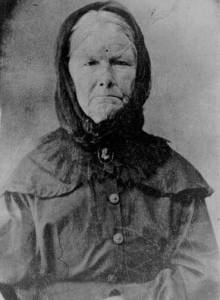
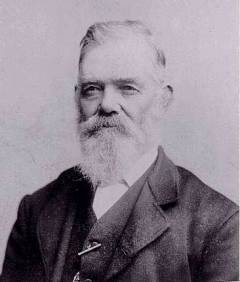 As this roll-call illustrates,
most members of the May family chose to support the Confederacy.
However, at least one member of the clan favored the Union cause.
Fred T. May points out that Reuben May (1815-1902),
son of Thomas and Dorcas Patton May and a nephew of Samuel
May, enlisted in the Union Army on September 23rd, 1861.
During the war Reuben advanced to through the ranks to
become Colonel of the 7th Kentucky Infantry. He saw action
in a number of famous battles, including Perryville (1862) and
Stones River (1863). After the war he moved to
As this roll-call illustrates,
most members of the May family chose to support the Confederacy.
However, at least one member of the clan favored the Union cause.
Fred T. May points out that Reuben May (1815-1902),
son of Thomas and Dorcas Patton May and a nephew of Samuel
May, enlisted in the Union Army on September 23rd, 1861.
During the war Reuben advanced to through the ranks to
become Colonel of the 7th Kentucky Infantry. He saw action
in a number of famous battles, including Perryville (1862) and
Stones River (1863). After the war he moved to 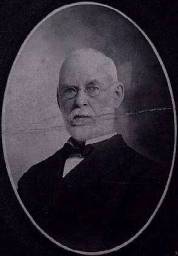 The son who inherited
Samuel's driving ambition was Andrew Jackson May,
known to his contemporaries as Jack. Born in 1829, Jack
reached adulthood during the period when his father's business
empire was collapsing. Fiercely loyal, he shared his father's
dream of recouping the family fortune, and in 1849, when he was
twenty, he accompanied Samuel on an ill-fated journey
to the California gold fields. Following Samuel's death
in 1851, he returned to Kentucky, settled in Prestonsburg,
and began studying for the law. He was licensed to practice in
1854, and in 1855 he married Matilda Davidson, the daughter
of a prosperous Floyd County farmer. By 1860, according to Paintsville
historian John B. Wells III, Jack was practicing law in
West Liberty, a town thirty-five miles west of Prestonsburg
in Morgan County, Kentucky.
The son who inherited
Samuel's driving ambition was Andrew Jackson May,
known to his contemporaries as Jack. Born in 1829, Jack
reached adulthood during the period when his father's business
empire was collapsing. Fiercely loyal, he shared his father's
dream of recouping the family fortune, and in 1849, when he was
twenty, he accompanied Samuel on an ill-fated journey
to the California gold fields. Following Samuel's death
in 1851, he returned to Kentucky, settled in Prestonsburg,
and began studying for the law. He was licensed to practice in
1854, and in 1855 he married Matilda Davidson, the daughter
of a prosperous Floyd County farmer. By 1860, according to Paintsville
historian John B. Wells III, Jack was practicing law in
West Liberty, a town thirty-five miles west of Prestonsburg
in Morgan County, Kentucky. General William Tecumseh
Sherman
General William Tecumseh
Sherman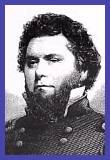 General William Nelson
General William Nelson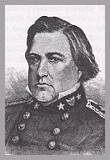 General Humphrey Marshall
General Humphrey Marshall General James Longstreet
General James Longstreet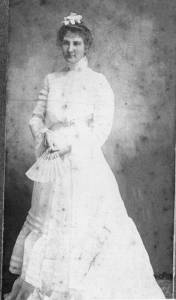 During their years
in Tazewell, Jack and Matilda raised six children,
four of whom reached adulthood: Byrd May, Samuel Davidson
May, Andrew Jackson May, Jr., and Mary Catherine May.
Following Matilda's death in 1901, Jack married a second time.
On June 17th, 1902, in Tazewell, he married Nellie Bly
Davidson (1878-1918) of Prestonsburg, a lady forty-nine years
his junior. Here is a photo of Nelle in her wedding dress.
During their years
in Tazewell, Jack and Matilda raised six children,
four of whom reached adulthood: Byrd May, Samuel Davidson
May, Andrew Jackson May, Jr., and Mary Catherine May.
Following Matilda's death in 1901, Jack married a second time.
On June 17th, 1902, in Tazewell, he married Nellie Bly
Davidson (1878-1918) of Prestonsburg, a lady forty-nine years
his junior. Here is a photo of Nelle in her wedding dress.